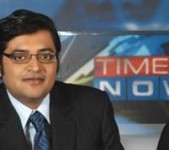The post-siege coverage
Is there is a need for our channels to carry Pak propaganda? Or to display self righteousness, or to indulge in self promotion on such occasions,
asks S R RAMANUJAN

The rare spectacle of unity and political consensus the Lok Sabha recently displayed to the world at large was lapped up (and rightly so) by the Indian media as if to atone for the rampaging campaign it ran against the political class. As everyone knows by now, the urban elite who came out for the first time onto the streets of Mumbai and Delhi immediately after Mumbai carnage, was exploited by the media. It used the elite to cover up its insensitivity and amateurishness in covering an event of such a great magnitude. Viewers were made to feel, because of the media hype, that the entire country is up against the politicians. There is also a view that this was a deliberate diversionary tactic to give an escape route to the ruling class, so that public wrath will not be directed against them exclusively. Whatever it is, the overwhelming criticism in the blogs against the media coverage forced the group editor of a channel to come up with a long-winding defence. That was much worse because it was so self-righteous that one got the impression that a journalist can never commit a mistake and those who point fingers at the media are the sinners.
Leaving aside the controversy over the coverage of the Mumbai siege, we must admit that modesty is also not one of the virtues of some of our presenters. No, I am not talking about the "exclusive", "first on..." "only on...." tags claimed by some channels for the footage provided by security agencies or the ones that are simultaneously appearing on other channels. For example, the profiles of nine dead terrorists released by the Mumbai police cannot be exclusive to one channel. On the question of modesty, I saw at least one anchor in a national channel claiming that it was the media campaign against the political class that brought them together on the floor of the Parliament. May be yes, May be no. But to claim it as credit is not an act of modesty.
On the day of Parliamentary debate on terror, the Times Now chief Arnab Goswami applauded the political parties all through his talk show, but the sting was in the tail. He asked a BJP spokesperson whether the nation would have witnessed the same sense of unity, if the Delhi election results were otherwise. In other words, it is the electoral defeat in Delhi and Rajasthan that brought the BJP on its knees. Otherwise, the party would have continued its confrontationist approach. That was what he meant. I won¿t say there is anything wrong journalistically in such a question. But the occasion did not warrant such cynicism. Similarly, the CNN-IBN chief Rajdeep Sardesai was trying his best, rephrasing his questions a number of times, to get a quote from former External Affairs Minister Yashwant Sinha that the military option was the only solution. Though Sinha had been repeating that "all options are open", the scroll was misquoting him saying "Sinha for military option" because that is the quote that anchor wanted from Sinha. The point here is that while the media wants the politicians to close their ranks in a war-like situation, it should not also try to queer the pitch with a display of its journalistic skills.
There is another dimension to the media coverage following the Mumbai siege. At times, I wonder whether I am watching Indian news channels or Pakistani news channels. Everyday at least two or three Pak mediamen or retired Army chiefs appear on our channels and none of them have anything to say objectively except to repeat the rhetoric "where is the evidence" Some of them go to the extent of saying that the Mumbai carnage was the handiwork of the locals. Is there is a need for our channels to carry Pak propaganda? Democracy is all about debate and discussion. Agreed. But we should be able to distinguish between debate and propaganda. The government, its non-state actors and the media men in Pakistan seem to be united in their state of denial. Should we have to purvey that propaganda to our viewers religiously in the name of talk shows? A Pak panellist on one such show said that the orange thread tied to the hand of a dead terrorist was a clear pointer to the evidence that the attack was by a non-Muslim group from within. Is it right on the part of our channels to purvey this rubbish to our viewers when Indian news channels are not shown on cable television anywhere in Pakistan?
Print is no exception. The Indian Express (Dec 16) carried an edit page piece by a Pakistan Supreme Court Lawyer Anees Jillani (Voices from Pakistan). According to him, "public opinion is growing for a call to ask India to extradite Col Srikanth Purohit and Sadhvi Pragya Thakur (arrested in connection with the Malegaon blasts) for being responsible for killing Pakistanis in the samjhauta Express blast and other Muslims elsewhere in India". This was repeated by Pak panelists on the Indian news channel talk shows as well with no rebuttal from our anchors!
The question is should the Indian media continue to be the carrier for Pak propaganda material? It is better the media goes in for an introspection before forcing the establishment to think of some restrictions on the lines of a code for covering terror attacks. As we always say, extraordinary situations require extraordinary remedies. We are in one such extraordinary situation.